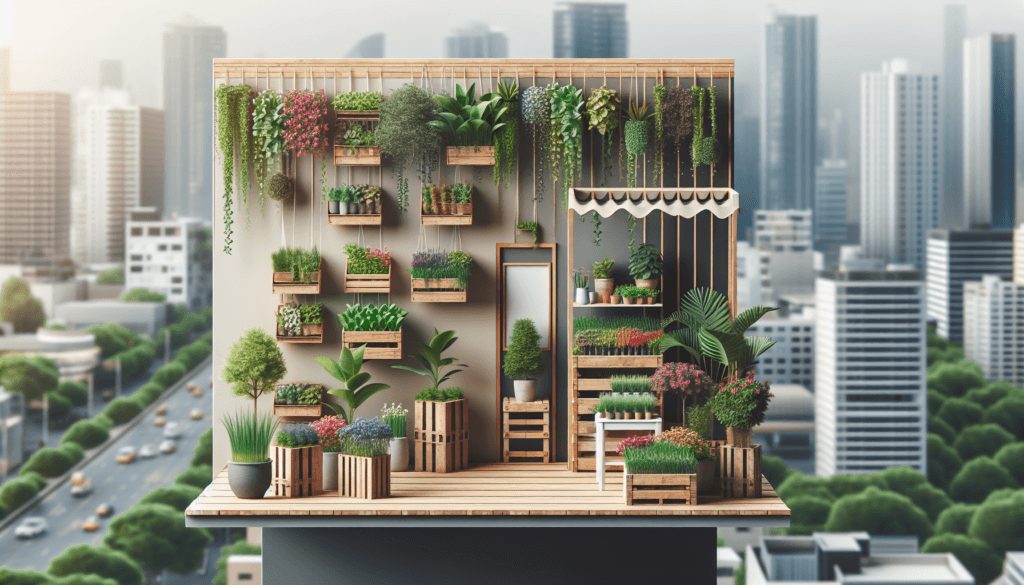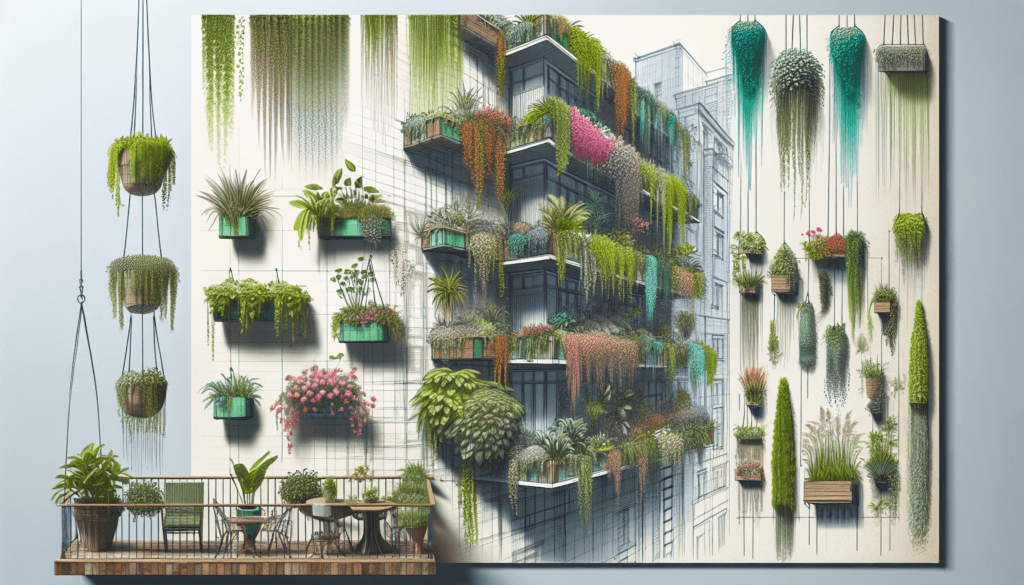Are you an urban dweller with a green thumb? Do you dream of having your own garden, but are limited by the lack of space in your city apartment? Well, fret no more! In this article, we will explore the top ways to make the most out of the vertical space available to you, allowing you to create a thriving garden in the heart of the concrete jungle. Say goodbye to cramped living quarters and hello to lush greenery that will bring life and tranquility to your urban abode.

1. Vertical garden walls
Vertical garden walls are a fantastic way to maximize your gardening space in urban environments. Whether you have a small balcony or a large outdoor area, vertical garden walls offer a visually appealing and space-efficient solution to grow your favorite plants. Here are some popular methods for creating vertical garden walls:
1.1 Using trellises and arbors
Trellises and arbors are commonly used to support climbing plants and create stunning vertical garden walls. These structures can be made from various materials such as wood, metal, or even PVC pipes. When choosing a trellis or arbor, consider the size and weight of the plants you want to grow. Ensure that the trellis or arbor is securely installed and can withstand the weight of the plants as they grow and climb.
1.2 Hanging planters
Hanging planters are a versatile and space-saving option for vertical gardening. You can hang planters from walls, trellises, or even overhead beams. There are various types of hanging planters available, from traditional pots with hooks to modern designs that allow for easy watering and drainage. When choosing hanging planters, consider the weight of the plants and the durability of the materials.
1.3 Pocket planters
Pocket planters are a creative way to create a lush vertical garden wall. These planters typically have multiple pockets or compartments where you can insert plants. They can be made from fabric, felt, or even recycled materials such as old shoe organizers or pallets. Pocket planters are great for growing herbs, flowers, or small vegetables. Hang them on flat surfaces, such as walls or fences, and enjoy a beautiful and space-saving garden.
1.4 Modular vertical garden systems
Modular vertical garden systems are a popular choice for urban gardening enthusiasts. These systems consist of individual modules that can be stacked or attached to create a customized vertical garden wall. Each module typically has its own planting space and allows for easy watering and drainage. Modular systems are suitable for a wide range of plant varieties and offer flexibility in terms of size and design.
2. Hanging baskets and pots
Hanging baskets and pots are a classic and effective way to utilize vertical space for gardening. With a variety of styles and materials available, you can easily find the perfect hanging baskets and pots to complement your outdoor space. Here are some tips for successful vertical gardening with hanging baskets and pots:
2.1 Choosing the right plants
When selecting plants for your hanging baskets and pots, consider their growth habits, sunlight requirements, and maintenance needs. Opt for plants that are well-suited for container gardening and can thrive in limited space. Some popular choices include trailing plants like ivy, colorful flowering plants such as petunias or begonias, and even herbs or vegetables in hanging pots.
2.2 Proper hanging techniques
To ensure the safety and stability of your hanging baskets and pots, it’s essential to use proper hanging techniques. Choose strong and secure hooks or hangers that can support the weight of the plants and the potting soil. When hanging the baskets and pots, make sure they are evenly spaced and at a comfortable height for easy watering and maintenance.
2.3 Maximizing space with tiered hanging baskets
To make the most of your vertical space, consider using tiered hanging baskets. These are baskets or pots that are stacked vertically, allowing you to grow multiple plants in a compact area. Tiered hanging baskets create a visually stunning display and are perfect for showcasing a variety of plants with different colors and textures. Make sure to choose plants with similar watering and sunlight requirements to ensure their wellbeing.

3. Window boxes and balcony railings
If you have limited ground space, window boxes and balcony railings provide excellent opportunities for vertical gardening. They allow you to bring greenery and color to otherwise unused areas. Here’s how you can make the most of these spaces:
3.1 Selecting appropriate plants for window boxes
When it comes to window boxes, choose plants that can thrive in the amount of sunlight your window receives. If your window faces south and receives direct sunlight for most of the day, opt for sun-loving plants like geraniums, petunias, or marigolds. For windows that receive partial sunlight, consider plants like impatiens, begonias, or ferns. Herb gardens are also a great option for window boxes, as they can provide fresh ingredients for your cooking.
3.2 Securing window boxes and railings
Properly securing your window boxes and balcony railings is essential to prevent accidents and ensure the longevity of your plants. Use sturdy brackets or brackets specifically designed for window boxes to secure them to the window sill or railing. Make sure the boxes are level and securely fastened to prevent them from falling or becoming unstable, especially during adverse weather conditions.
3.3 Cascading plants for added visual appeal
To create an eye-catching display, consider incorporating cascading plants in your window boxes or balcony railings. Plants like trailing vines, ivy, or bacopa can spill over the edges and create a lush and dynamic visual effect. These plants not only add beauty but also soften the lines of the containers, creating a more organic and natural look.
4. Living walls with vertical planters
Living walls, also known as green walls or vertical gardens, are a stunning way to beautify your outdoor space and improve air quality. These vertical planters create a vibrant and eco-friendly display by covering entire walls with plants. Here’s what you need to know about living walls:
4.1 Benefits of living walls
Living walls offer numerous benefits, both aesthetic and ecological. They improve air quality by filtering pollutants, help reduce noise levels, and can even reduce energy consumption by providing insulation. Additionally, living walls can create a sense of serenity and well-being, adding a touch of nature to urban environments.
4.2 Choosing the ideal location for a living wall
When planning a living wall, consider the amount of sunlight the chosen location receives and the water source availability. Most plants used in living walls require a good amount of natural light, so it’s crucial to choose a spot that receives enough sunlight throughout the day. Additionally, ensure there is easy access to water for irrigation, whether it’s through a drip system or manual watering.
4.3 Plants suitable for living walls
Not all plants are suitable for living walls, as they need to be able to thrive in vertical conditions. Look for plants that have shallow root systems, are drought-tolerant, and can withstand variations in temperature and humidity levels. Some popular choices include ferns, succulents, mosses, and even certain types of herbs. Make sure to select plants that will create a visually appealing composition and take into account their different growth habits and colors.

5. Tiered plant stands and shelves
Tiered plant stands and shelves are an excellent option for those looking to add greenery to their indoor or outdoor spaces. These versatile structures allow you to maximize vertical space while creating an aesthetically pleasing display. Here’s how you can make the most of tiered plant stands and shelves:
5.1 Utilizing vertical space with tiered stands
One of the main advantages of tiered plant stands and shelves is their ability to utilize vertical space effectively. By stacking plants on different levels, you can showcase a variety of plant varieties, adding depth and dimension to your space. Place taller plants at the back and shorter ones at the front to create a visually appealing arrangement.
5.2 Arranging plants to maximize sunlight exposure
When setting up your tiered plant stand or shelves, consider the sunlight that each plant requires. Place sun-loving plants on the top tiers where they will receive the maximum amount of sunlight. Shade-loving plants can be placed on lower tiers or closer to walls or structures that provide some shade. By strategically arranging your plants, you can ensure that each one receives the appropriate amount of light for optimal growth.
5.3 Choosing the right materials for plant stands
When selecting tiered plant stands or shelves, consider the materials that best suit your style and the environment where they will be placed. Wood, metal, and even bamboo are popular choices for their durability and aesthetic appeal. Make sure that the materials are sturdy enough to support the weight of the plants and withstand the elements if the plant stand will be placed outdoors.
6. Vertical herb gardens
Growing herbs vertically is a practical and flavorful way to make the most of your gardening space. Whether you have a small balcony or a sunny kitchen windowsill, vertical herb gardens can provide fresh ingredients for your meals and add a touch of greenery to your space. Here are some popular methods for growing herbs vertically:
6.1 Hanging herb gardens
Hanging herb gardens are perfect for those with limited space. Hang herb pots or baskets from hooks, railing, or even a sturdy rod attached to the ceiling. This method allows you to grow various herbs in individual containers, making it easy to care for and harvest them as needed. Using hanging herb gardens also adds a decorative element to your space.
6.2 Vertical wall planters for herbs
Vertical wall planters offer a stylish and functional way to grow herbs vertically. These planters can be attached to walls indoors or outdoors, creating a striking display of herbs. Some vertical wall planters have separate compartments for each herb, while others have a modular design that allows you to customize the arrangement. Consider the sunlight requirements of your herbs and choose a suitable location for your vertical wall planters.
6.3 Utilizing unused outdoor corners for herb gardens
If you have unused corners in your outdoor space, consider transforming them into herb gardens. Use planters or raised beds to create a designated area for your herbs. Take advantage of the vertical space by using trellises or stakes to support climbing herbs such as rosemary or mint. Make sure to position your herb garden in an area that receives adequate sunlight and is easily accessible for watering and harvesting.

7. Vertical hydroponic systems
Hydroponic gardening is a soil-free method of growing plants using a nutrient-rich water solution. Vertical hydroponic systems provide an innovative way to grow plants vertically while conserving space and resources. Here’s what you need to know about vertical hydroponic systems:
7.1 Advantages of hydroponic gardening
Hydroponic gardening offers several advantages over traditional soil-based gardening. It allows for precise control of nutrient delivery to plants, resulting in faster growth and higher yields. Hydroponic systems also use less water compared to conventional gardening methods, making them environmentally friendly and suitable for water-scarce areas. Additionally, the absence of soil eliminates the risk of soil-borne diseases and weeds.
7.2 Setting up a vertical hydroponic system
Setting up a vertical hydroponic system requires some planning and organization. Determine the size and scale of the system based on the available space and your plant requirements. Select appropriate vertical hydroponic towers or panels that can accommodate the number of plants you want to grow. Install a nutrient circulation system and ensure proper lighting and ventilation for optimal plant growth.
7.3 Selecting appropriate hydroponic plants
When choosing plants for your vertical hydroponic system, consider their compatibility with hydroponic growing methods. Leafy greens like lettuce, spinach, and kale are popular choices for vertical hydroponic systems due to their quick growth and compact size. Herbs such as basil, parsley, and cilantro also thrive in hydroponic environments. Start with a few varieties of plants and experiment with different crops as you become more familiar with hydroponic gardening.
8. Vertical stacking and tiered containers
Vertical stacking and tiered containers offer a creative way to maximize space and create an eye-catching display. By using containers that can be stacked or placed on top of each other, you can grow multiple plants in a compact area. Here’s how you can make the most of vertical stacking and tiered containers:
8.1 Stacking containers for space efficiency
Vertical stacking containers, also known as stacking planters or stackable pots, allow you to grow multiple plants in a small space. These containers have separate compartments that can be stacked on top of each other, creating a vertical garden tower. When selecting stacking containers, ensure that they provide adequate drainage to prevent waterlogged roots and that they are stable when stacked.
8.2 Benefits of tiered container gardens
Tiered container gardens create a visually appealing and organized display of plants. By arranging plants on different levels, you can easily showcase a variety of plant varieties, colors, and textures. Tiered gardens are perfect for small spaces, such as balconies, patios, or even kitchen countertops. They also make watering, pruning, and harvesting more convenient, as each plant is easily accessible.
8.3 Creatively repurposing containers for vertical gardening
When it comes to vertical stacking and tiered container gardens, you can get creative with the materials you use. Repurpose old containers such as buckets, plastic bottles, or wooden crates to create your vertical garden. Make sure to provide adequate drainage and consider adding a layer of waterproof lining or sealing to prevent water damage. Not only will this approach save you money, but it will also add a unique and personal touch to your vertical garden.

9. Trellises and supports for vine plants
Vine plants, such as tomatoes, cucumbers, or beans, require support to grow vertically and maximize their productivity. Trellises and supports provide a sturdy framework for these plants to climb, ensuring proper air circulation and reducing the risk of diseases. Here’s what you need to know about trellises and supports for vine plants:
9.1 Different types of trellises and supports
There are various types of trellises and supports for vine plants, including stakes, cages, and arched structures. Stakes are typically made of bamboo or metal and are pushed into the ground near the plant, providing a single support point. Cages are wire mesh structures that surround the plant, allowing it to grow through the gaps. Arched structures, such as arbors or pergolas, provide a larger framework for the plants to climb.
9.2 Training vine plants on trellises
Training vine plants on trellises is essential for their proper growth and support. As the plants grow, gently guide the main stem or tendrils towards the trellis or support structure. Use garden twine or clips to secure the plants to the trellis, ensuring they are evenly spaced and have room to grow. Regularly check on the plants and prune any excess foliage to promote airflow and prevent overcrowding.
9.3 Using vertical supports for vertical gardening
Vertical supports not only provide structural stability for vine plants but also utilize vertical space effectively. By training vine plants to grow vertically, you can save valuable ground space and create an organized and aesthetically pleasing garden. Vertical supports also make it easier to care for and harvest the plants, as they are at a more convenient height.
10. Utilizing fences and walls
Fences and walls are often overlooked vertical spaces that provide excellent opportunities for gardening. By utilizing these structures, you can create beautiful and functional gardens that blend seamlessly with your outdoor surroundings. Here are some ways to make the most of fences and walls for vertical gardening:
10.1 Growing plants vertically on fences
Growing plants vertically on fences is a simple and effective way to utilize otherwise unused space. Install trellises or wire mesh panels on the fence to provide support for climbing plants. Depending on your preference, you can choose to grow flowering vines, trailing plants, or even edible plants like beans or peas. Ensure that the fence is strong enough to support the weight of the plants as they grow.
10.2 Vertical gardens on outdoor walls
Transforming outdoor walls into vertical gardens can add a striking focal point to your outdoor space. Attach modular vertical garden systems or individual planters to the wall, creating a living work of art. When planting on walls, consider the weight of the soil and plants to ensure proper installation and longevity. Regular maintenance is essential to prevent water damage or damage to the wall surface.
10.3 Incorporating hanging planters on fences
Hanging planters are a versatile option for vertical gardening on fences. Hang containers from hooks or brackets attached to the fence, creating a vibrant and colorful display. You can mix and match different types of hanging planters, such as baskets, pots, or even repurposed containers. Experiment with various plant combinations to create an eye-catching arrangement and bring life to your fence.
In conclusion, utilizing vertical space for urban gardening opens up a world of possibilities for green enthusiasts. Whether you choose to create vertical garden walls, hang baskets and pots, utilize window boxes and balcony railings, or embrace living walls, tiered plant stands, and shelves, there are countless ways to bring nature into the urban landscape. By following these tips and exploring the different methods discussed, you can create a lush and thriving garden regardless of limited space constraints. Happy gardening!

